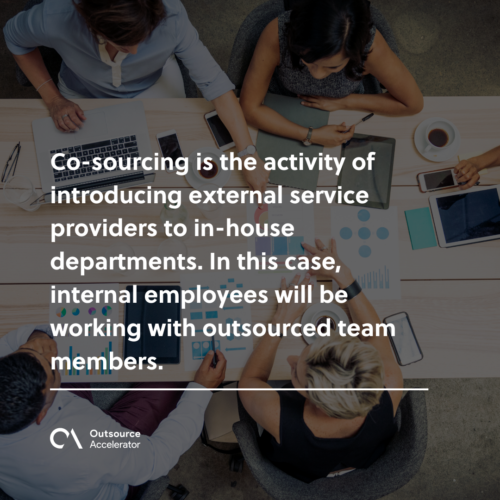What is co-sourcing and how does it help?

With companies looking for effective ways to cut expenses, a variety of cost-cutting strategies have popped up throughout the years.
Applying a co-sourcing model is one way to lessen workplace expenses—a business model that has taken a page out of outsourcing’s book.
Employers everywhere are keen to try a system that will reduce costs and maintain the quality of work.
Defining co-sourcing in 2025
Co-sourcing is the activity of introducing external expertise and service providers to in-house departments. In this case, internal employees will be working with outsourced team members.
Outsourced employees may or may not be in the same office as an internal team. The former can telecommunicate and work remotely alongside their teammates.
These two units must work together and achieve the same goals.

Co-sourcing vs. Outsourcing
One major difference between co-sourcing and outsourcing is the model in which they operate. The former exists in a hybrid-like work setup, while the latter can be an all-in, all-out setup.
When evaluating the difference between co-sourcing and outsourcing in the context of an internal audit function, it is crucial to understand the unique roles each arrangement offers.
To put it simply, one exercises internal-external employee teamwork more than the other.
Outsourcing itself has its advantages, but having an outsourced team of external professionals working harmoniously with internal employees may reap greater benefits for a company.
Co-sourcing represents a collaborative effort where the internal audit provider works alongside a co sourcing partner to complement the existing team’s skills and resources.
Business processes you can co-source
The list of activities below isn’t exhaustive, but it’s a good jump-off point for businesses new to the process. Availing of co-sourcing services is a major decision that will impact the company’s employees.
Any major business decision should be made transparently and for the benefit of the majority. If executed otherwise, it may create a negative work environment that affects employee morale.
Content creation
From content writing to commercial and film production, businesses can often find freelancers—or “outside” help—for any content.
Businesses can start with an in-house team of creators and a manager and slowly add freelancers and independent contractors.
This way, more content can be produced more sustainably and cost-effectively.
Human resources
Serving as the heart and soul of any company, the human resource department can benefit greatly from co-sourcing. Many recruitment process outsourcing (RPO) companies cater to selective outsourcing, including but not limited to:
- Background checking
- Candidate sourcing
- Initial interview
- End-to-end recruitment process
External service providers can assist with these activities, while in-house employees focus on employee engagement and other internal affairs.
Back-office activities
Data entry and clerical work are just some of the jobs that back-office associates do on a daily basis.
The back-office department is another great area in which to introduce selective outsourcing. Companies can save resources by eliminating redundancies in the workplace.
By working with a hybrid of internal and external employees, businesses can maintain and hit their key performance indicators (KPIs) without shelling out more money.
Telemarketing
There is a lot involved in telemarketing. From lead generation to cold calling, telemarketers face their prospects day in and day out, and they have goals, quotas, and KPIs to meet.
So, why not introduce selective outsourcing to the telemarketing department? The more heads in the game, the more chances there are of getting multiple clients and closing deals.

Advantages of co-sourcing
Co-sourcing serves as a stepping stone into hiring external service providers, allowing decision-makers to take a peek at what’s to come.
Co-sourcing offers several advantages for internal audit teams, fund managers, and private equity firms.
Here are the benefits that co-sourcing offers companies.
More strength in numbers
Co-sourcing means more people but not more cost. That means you can get more out of your expanded team without having to spend extra on overhead expenses and worker benefits.
Further, time wasters at work would be negated, and internal staff would be inspired to put in the same amount of work as everyone else.
Leveraging a co-sourcing partnership, you gain more strength in numbers, enabling access to specialized expertise and talent beyond your internal audit staff.
This collaborative approach also allows for in house fund administration, providing a tailored and seamless solution to your financial needs.
Co-sourcing facilitates internal audits more efficiently, resulting in a deeper understanding of risks and controls within your organization.
Harnessing co-sourcing effectively, you can achieve a competitive advantage in the market, enhancing your overall performance and profitability.
Lower cost
Say a department has 50 internal staff who are paid $20 per hour, and then management introduces 50 co-sourced workers paid at a fixed cost of $10 per hour.
They would essentially have a whole unit’s worth of people at half the price.
As mentioned, the company also wouldn’t have to worry about additional overhead costs such as utilities and space rental usually associated with expanding in-house teams.
Stricter quality assurance process
With internal employees knowing the best practices in place, outputs from outsourced employees may be subjected to a much stricter QA process.
This will help the management set examples and expectations.
Team managers can put systems in place to filter out exemplary work from both internal and external employees.
Is co-sourcing beneficial to both vendor and client?
The practice of co-sourcing is indeed beneficial to both parties. As mentioned above, those advantages can be seen in companies that dabbled in the outsourcing industry.
It can be beneficial in many ways, and the only way to discover it is to try it out.
Business process outsourcing (BPO) companies have the capacity to assist organizations looking for assistance, especially when starting out.
Co-sourcing can indeed be highly beneficial to both vendors and clients in the financial industry, particularly in areas such as data management, asset managers, portfolio management, regulatory compliance, and fund management.







 Independent
Independent




